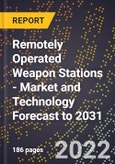Market forecasts by Region, System Element, and End-User. Country Analysis, Market and Technology Overview, Opportunities and Impact Analysis, and Leading Company Profiles
After more than 20 years of use in the field, Remotely Operated Weapon Stations have become a well-established market. The advantages they offer are significant, including crew protection, increased accuracy, first-round hit probability, target recognition and identification, low production, integration, and operational cost. Most importantly they can significantly increase the firepower of smaller and legacy platforms, thus increasing their range of capabilities or extending their utility in the modern battlefield.
The outbreak of the war in Ukraine has shown that a confrontation between peer or near-peer competitors is not a possibility that could happen in the distant future, but a highly like scenario. In such confrontations, firepower, long-range fires and ISR are elements that play a key role. However, the defence industries were unprepared for the requirements of a high-intensity warfare, and they have been struggling to deliver the required capabilities. That is an issue further exacerbated by the risks posed by the current economic and political climate which impacts defence budgets and supply chains.
In such a tight framework ROWS can deliver significant capabilities to new and legacy platforms in a timely and affordable manner. There is also an important development in the ROWS market that no one should disregard, as they are expected to change the conduct of combat operations. Just as radio brought a small revolution in technical and military affairs when it was used as a medium to guide weapons, ROWS will bring a similar change, not only as standalone systems but also as part of a networked environment and on top of unmanned ground or surface vehicles.
The current global security environment poses many challenges either in the form of low-intensity conflicts too. With major forces around the globe being in need of fielding disruptive technologies with fire delivery capabilities, platforms or unmanned systems with ROWS, interconnected through IoMT over a C2 backbone, will serve that goal effectively and affordably.
Recognizing that potential of the market, a significant number of manufacturers around the world are positioning themselves by developing their own ROWS. That creates a highly competitive environment for businesses, which will be better served through the creation of economies of scale.
Market Forecast provides a detailed analysis of the Remotely Operated Weapon Stations (ROWS) market up to 2031 in terms of technologies, end-users and platforms, acquisition programs, leading companies, and opportunities for manufacturers. The report also provides the case studies that would help readers better understand the nature of the market and the underlying factors affecting the procurement of ROWS.
Covered in this report
- Global market share assessments for all types in numbers delivered and value up to 2031.
- Market share assessments per segments and regions up to 2031.
- Snapshot on global security issues, defence budgets, spending patterns and how these affect the procurement of ROWS systems.
- Focus on US, European, Asian-Pacific and Middle East procurement programmes.
- Case studies with some of the world’s biggest acquisition programs that have ROWS an integral part of the equation.
- Market Dynamics: An insight on the latest technological developments in the ROWS market and which countries are changing their preferences, are in position to absorb the new technology and adapt their modus operandi.
- Roles for all types: Insight on how ROWS fit into a military or security concept of operations and how they form a revolution in military affairs.
- Main military ROWS technological trends.
- Market Trends: Drivers, Trends, Opportunities and Risks for the stakeholders that want to stay ahead of the competition.
- Profiles for the leading companies.
Segmentation
We have segmented the market by Region, Application (domain), and End-Use.
Region
- Americas
- Europe
- APAC
- Middle East & Africa
Application
- Land domain
- Naval domain
End-Use
- Defence
- Security
Reasons to buy this study
- The report 'Remotely Operated Weapon Stations - Market and Technology Forecast to 2031' will be of help to existing companies and new market entrants in this sector.
- The 'Market Analysis and Forecast Factors' helps to understand how the market will evolve
- The 'Technologies and Developments' chapter helps companies with investment choices.
- Strategy formulation teams can use the market forecast chapter to understand the future market potential, this would help them to converge their efforts to specific segment.
- The sales team can use the market forecast chapter to plan their sales campaigns and focus areas.
- Scenarios with potential and unpredictable factors are identified in the Impact Analysis Chapter
- The Opportunity Analysis chapter shows the market growth for the segments.
- The company profiles chapter contains financial information, products, recent contract, and a SWOT analysis
Who is This Report For?
This report is a must, particularly if you are one of the following:
- Business Leaders & Business Developers
- Market Analysts
- Government and Military decision-makers
- Component manufacturers
Table of Contents
Companies Mentioned
- ADS Malaysia
- Aselsan
- BAE Systems
- Bohemian Interactive Solutions
- CTA International
- John Cockerill
- EDGE Group
- Elbit Systems
- EOS Australia
- Escribano Mechanical and Engineering
- FN Herstal
- General Dynamics Land Systems
- KMW
- Kongsberg
- Leonardo
- Milrem Robotics
- Moog
- MSI-Defence Systems
- Nexter
- Patria
- QinetiQ
- Rafael
- Reutech
- Rheinmetall
- Saab
- Thales
- Valhalla Turrets








